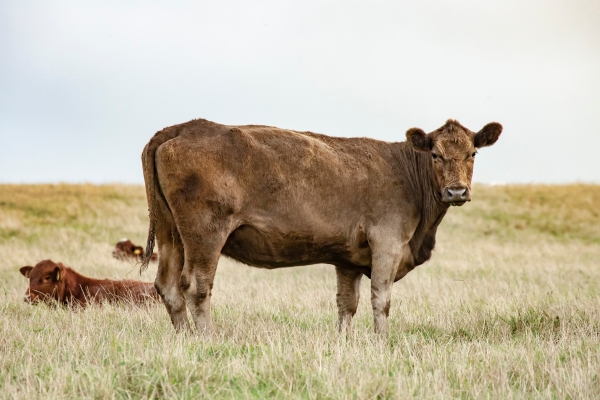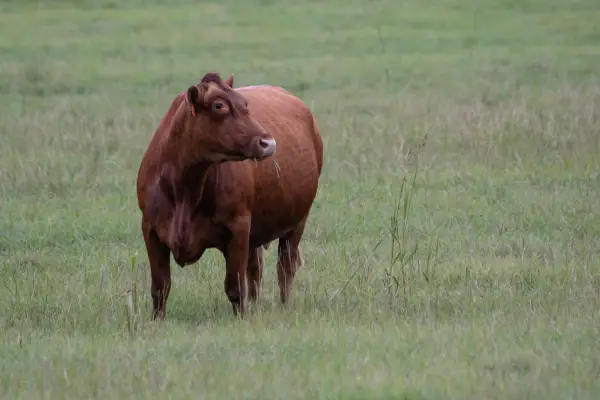Gelbvieh Cattle Breed
The Gelbvieh (pronounced “gel-fee”) cattle breed originated in Germany and is known for its muscular build, efficient growth, docile temperament, and high carcass quality.
In this blog article, we will cover the origin, characteristics, advantages, disadvantages, interesting facts, common uses, arrival to America, notable traits, and life expectancy of this popular beef cattle breed.
Origin of Gelbvieh Cattle
The Gelbvieh breed was developed in the mid-1800s in the pastoral valleys of southern Germany in the states of Bavaria and Baden-Württemberg. “Gelbvieh” means “yellow cattle” in German, named for the golden-wheat colored hides of these cattle under the hot summer sun.
German farmers selectively bred local cattle to emphasize traits like fertility, milk production, rapid growth, muscle mass, and adaptability to mountainous grazing environments. The resulting Gelbvieh or German Yellow breed proved hardy, efficient, and well-suited to thrive on marginal pasturelands while producing high-quality beef.
Today, purebred Gelbviehs in Germany continue to be among the world’s most elite beef animal genetics, carefully documented for purity and performance since the early 19th century establishment of the breed.
Characteristics of Gelbvieh Cattle
Gelbvieh cattle are medium-large framed bovines with extremely muscular builds that carry nicely down to the hock and knees. They exhibit docile temperaments amid humans and herdmates. Some key physical attributes include:
- Coat Color: Golden to wheat-toned hair with creamy or tan markings; dark eyes and muzzle
- Size: Mature bulls weigh 1,800-2,500 lbs; cows 1,200-1,500 lbs
- Horns: Naturally polled (hornless); small horns possible but not preferred
- Udder & Teats: Well-attached, high and tight udders with small teats
Advantages of Gelbvieh Cattle
Gelbvieh cattle offer numerous advantageous traits for beef producers including:
- Hybrid Vigor: Gelbvieh crossed with other breeds exhibits exceptional hybrid vigor, heterosis, and complementarity
- Calving Ease: Heifers experience easy first calvings without assistance
- Fertility: Cows have excellent conception rates and calving intervals
- Mothering Ability: Cows are very maternal with ample milk production
- Calf Survivability: Hardiness for survival and weaning weight
- Foraging Ability: Adaptability to graze marginal lands or finish on grain
- Lean Yield: High dressing percentage with well-marbled beef
- Docility: Gentle dispositions amid handling and transport
Disadvantages of Gelbvieh Cattle
Potential downsides of Gelbvieh cattle include:
- Purebreds Less Available: Purebreds can be expensive if sourced overseas
- Larger Size: Mature females and breeding bulls require more nutrients
- Milk production: Adequate but less than elite dairy breeds
- Winter Hardiness: May require provision of wind/cold protection

Interesting Facts About Gelbvieh Cattle
- In 1971, Gelbvieh made history as the first Continental European beef breed imported into North America.
- Gelbvieh cattle helped pioneer the “exotic” beef craze by crossing imported genetics with traditional British breeds.
- An estimated 3.2 million Gelbvieh cattle exist in Germany; over 750,000 are registered worldwide.
- Gelbvieh semen is traded globally, representing billions in sales from top bloodlines.
- Gelbvieh translates to “yellow cow” but ranges from golden to tan to wheat-toned.
- The American Gelbvieh Association formed in 1971 to pedigreed purebred animals and promote hybrids.
- Multi-purpose Gelbviehs provide beef, milk, and draft power around the world.
Common Uses of Gelbvieh Cattle
As a docile, hardy, and versatile breed, some of the common uses of Gelbvieh cattle include:
- Providing Tender Beef: Gelbvieh is highly regarded for its fine marbling, calving ease, superior loin and rump cuts ideal for lean, flavorful steaks and roasts fit for high-end restaurants.
- Crossbreeding for Hybrid Vigor: Gelbvieh crossed with Angus, Hereford, Simmental and other breeds exhibits strong hybrid vigor; the F1 offspring display the best qualities of both parents for calf survival, mothering, milking, fertility, feed efficiency and finishing weight. These crosses are enormously popular in breeding programs.
- Upgrading Herds: Adding Gelbvieh genetics upgrades British-based commercial herds with superior muscling and disposition while maintaining marbling. Only one cross greatly enhances quality and yield grades.
- Balancing High-Producting Cows: Larger-framed continental breed daughters make excellent recipients for breeding to calving-ease Gelbvieh herd bulls in embryo transfer.
- Pasture Based Production: Gelbvieh females breed back well and wean heavy calves even when relying exclusively on grass. These low-input, high-output cows convert grass to growth efficiently.
When Did Gelbvieh Cattle Arrive in North America?
The first imports of German Gelbvieh cattle to North America occurred in 1971 by Canadian livestock breeders. These original purebred animals underwent strict quarantines for 2 years before entering approved breeding programs in Canada and the United States starting in 1973-1974.
Multi-color five generation “Gelbvieh Gold Book” pedigrees were maintained in Germany since the early 19th century by tracking parent stock bloodlines.
This emphasis on genetic purity assisted North American breeders in strategically selecting and importing the finest registered German bloodlines which formed the foundation of Gelbvieh purebreds established in North America over the past 40+ years of breeding.
What Are Gelbvieh Cattle Known For?
Gelbvieh beef cattle are recognized globally for excellence in these seven key areas:
- Easy Fleshing Ability
- Docility
- Fertility
- Milking Ability
- Calf Vigor & Survival
- Carcass Quality Grades
- Disposition Temperament
The hardy and fertile Gelbvieh female lines pass these stellar maternal traits to her progeny. When crossed with elite terminal sires, Gelbvieh-influenced offspring deliver premium graded beef to meet consumer demands.
Gelbvieh Cattle Life Expectancy
Under ideal conditions, the average lifespan for Gelbvieh cattle breeds is:
- Bulls: 10-14 years
- Cows: 15+ years
- Productive Breeding: 6-8+ calvings
- Peak Production Age: 4-8 years old
Gelbvieh cattle remain sound and robust, breeding annually beyond 10 years when body condition is maintained. Average cow longevity is impressively 15+ years. With great care and luck, a percentage of cows may calve into their late teens or reach 20 years old. Terminal sons and daughters of Gelbvieh bulls and females achieve finishing or market weights between 12-18 months when intensively managed.
Conclusion
In summary, Gelbvieh cattle offer beef producers a powerhouse combination of docility, fertility, tender highly-graded beef, and the hybrid vigor demanded by commercial operators. Their European origins may be a world away, but North American cattlemen have put purebred Gelbviehs and their crosses to work improving bottom lines across the beef industry.
With continued selection emphasizing calving ease, mothering ability, efficient growth, and carcass quality, Gelbvieh genetics will keep generating profits for generations to come.

